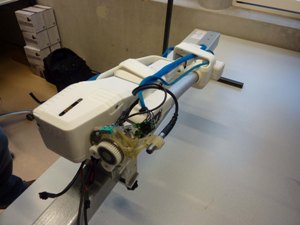Nov 24 2014
A new robot for inspecting ballast water tanks on board ships is being developed by a Dutch-German partnership including the University of Twente. The robot is able to move independently along rails built into the tanks. At the moment, people still carry out such inspections, with ships being brought into dry dock for the purpose.
The costs can rise to € 700,000 per inspection. The RoboShip project offers great advantages, not only in terms of cost but also in terms of safety.
 robotic arm for inspecting on board water tanks 2
robotic arm for inspecting on board water tanks 2
RoboShip is an independent, intelligent robotic platform on rails for use within the shipping industry. The parties involved in the RoboShip project brought together a number of innovations in it. Imotect, for example, developed a smart, cost-efficient rail, while DFKI was responsible for an autonomous vehicle to run along the rails. Incas³ developed the sensors, Xsens developed the tank navigation system, and the University of Twente was responsible for ensuring that a thorough inspection of the ballast water tanks is carried out using the equipment. The Meyer Werft shipyard in Germany has now also joined the project and will be integrating RoboShip into the ships it builds.
Operators are able to determine the exact position of the robot within the ballast water tanks thanks to a magnetic field. Other developments include a simple way of building synthetic rails into ships, an improvement to the supply of energy through the rails and advanced communication and navigation systems.
Current inspections: dangerous and expensive
Ballast water tanks are either filled with seawater or are left empty. Seawater is extremely aggressive and attacks steel. This is why regular inspection from within is required. Current practice is for a group of six inspectors to carry out such inspections. In doing so, they run the risk of injury through falls or of breathing in noxious gases. The autonomous RoboShip inspection robot makes such risks a thing of the past. Using the robot also greatly improves the efficiency of inspections.
Inspectors evaluate the data transmitted on a screen outside of the ballast water tank, considerably reducing the overall time required for inspecting a ship. The time that liners need to spend in dock can also be considerably reduced as tank inspections can take place while the ship is still in operation. Any repairs required can then be scheduled in before the ship goes to dry dock. Having a ship in dock is, after all, an expensive business, with costs running into the hundreds of thousands of euros. In the future, when the energy supply through the rails has been further improved, the robot will be able to work on the ballast water tank's surfaces using a laser. It will then be able
to remove paint residues, for example, and it will also become possible to clean and coat the tanks.
Robotic arm from Twente
Doctoral degree candidate Dian Borgerink of the Robotics and Mechatronics department at the University of Twente developed the build-on robotic arm for RoboShip, working together with the department's chairman, Stefano Stramigioli, and master's student Jop Huttenhuis. Borgerink also works for the INCAS³ research institute, which developed the sensor system on the arm.
"I have had the opportunity of seeing the inside of a freighter's ballast water tank," says Borgerink. "After a voyage, it is slippery with seaweed and is full of noxious gases. Tanks like these are almost inaccessible due to ribs, pipes and cables. Realising that people actually need to go into them to carry out inspection work was what motivated me to develop the robotic arm." While designing the robotic arm, Borgerink and his colleagues were presented with many challenges. The arm needed to be collapsible, lightweight and accurate. The research carried out has already been presented at IROS 2014 in Chicago, a leading conference for the robotics and automation sector.
The Roboship research is funded by the German-Dutch INTERREG IVA subsidy programme.